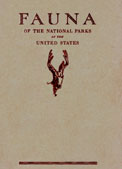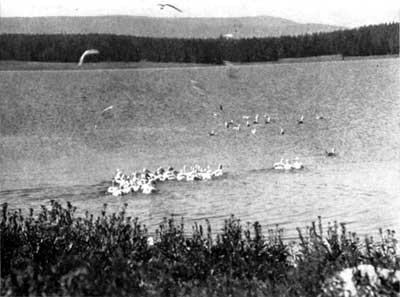![]()

Fauna Series No. 1
![]() Methods
Methods
Fauna of the National Parks
of the United States
PROBLEMS OF COMPETITIVE ORIGIN
DISTURBANCES ON BREEDING GROUNDS
(14)
Colony-nesting birds in general are intolerant of invasion of their breeding grounds. A constant trek of visitors may lead to abandonment of the colony. Inasmuch as some species do not easily find sites which are suitable for their particular nesting requirements they are likely to leave the park as well as the area from which they have been driven. The loss of any species in the faunal quota of the national parks is a tragedy.

FIGURES 34a, 34b. – Such large ground-nesting birds
as the sandhill crane can not
persist where there is much use of
their breeding grounds by people.
Photographs taken June 8, 1931, in
Bechler River district, Yellowstone, by G. M. Wright.
Wild Life
Survey Nos. 2310 and 2311
But even if the birds continue to frequent the colony, their numbers may be reduced from year to year through the destruction of eggs and young which accompanies the precipitate flight of the adults and prolonged absence from the nests. So the ultimate fate of the colony may be the same.
This situation can be readily met by making special administrative areas of the nesting grounds so that all entry may be barred during the critical season. The best interest of the birds can be safeguarded in this manner without appreciably restricting the use of the park as a whole. Moreover, under favorable circumstances, arrangements may be made for the observation of the activities going on in the colony from some vantage point near by.
Even solitary nesting species would be benefited by this type of protection in some instances. Any large ground-nesting bird that is rare should be investigated from this standpoint. If the Bechler River district of Yellowstone were ever developed (a move which the swarms of mosquitoes should effectively block), one of the last strongholds of the sandhill crane would be endangered. This bird can not nest successfully where there are many people. The following incident is illustrative. A member of the field party flushed a brooding sandhill crane. In its hurried departure the bird knocked an egg out of the nest. With a bird that lays two eggs to a clutch, such a loss is a serious matter and the crane is so rare that every individual is precious.
The problem of special protection on breeding grounds is a minor one in most parks, though, in the case of the proposed Everglades, the major objective of development would be to establish a mutually advantageous relationship between the visiting public and the great bird rookeries.
White pelican in Yellowstone. – Grotesque on land and superb in flight, the strange white pelican is one of the most interesting members of our avian fauna. It is estimated that the agency of man has reduced its numbers in the United States by half in the last quarter century. The only white pelican breeding colony now found within the confines of a national park is at Molly Island, in Yellowstone Lake. This is a small colony of between one and two hundred breeding pairs.
Human trespass on pelican islands during the breeding time is injurious to the birds in several ways, as E. Raymond Hall 18 has shown in his studies of the great colony at Pyramid Lake, Nev. Eggs are broken and the downy young are wounded or killed by strokes of feet and wings when the old birds are suddenly frightened into flight. A little later on the young pelicans mass together in pods. These pods stampede at the approach of an enemy, with the result that many individuals are trampled and left behind dead or dying. If the parents are driven off during the middle of the day, the pelican babies and eggs are killed by the heat of the sun; if at night, they will perish from cold, depending, of course, upon the length of exposure. Moreover, the white pelican is one of the birds that readily abandons a nesting island if it is disturbed. There are instances where this has happened and the birds have never returned.
The protection of the Molly Island colony is simplified because the island is sequestered in a southern arm of the lake. However, future developments could change all this, and even now precautions are necessary to prevent too many visits to the island.
Sanctuary status for species which have their rookeries on mainland requires more administrative effort, such as is involved in posting signs, erecting barriers across roads, and running special patrols.

FIGURE 35. – This pod of white pelicans,
representing the entire 1931 crop of the Molly Island
colony, fled at
our approach. When a pod is disturbed in this way while the birds are
younger,
some of its number may be trampled to death.
Photograph
taken July 18, 1931, at Molly Island, Yellowstone, by G. M.
Wright.
Wild Life Survey No. 2317
18 Pelicans versus Fishes in Pyramid Lake, by Hall, E. Raymond, the Condor, vol.XXVII, pp. 147-160, July, 1925.
Top
Last Modified: Tues,
Feb 1 2000 07:08:48 pm PDT
http://www.cr.nps.gov/history/online_books/fauna1/fauna3-14.htm
![]()